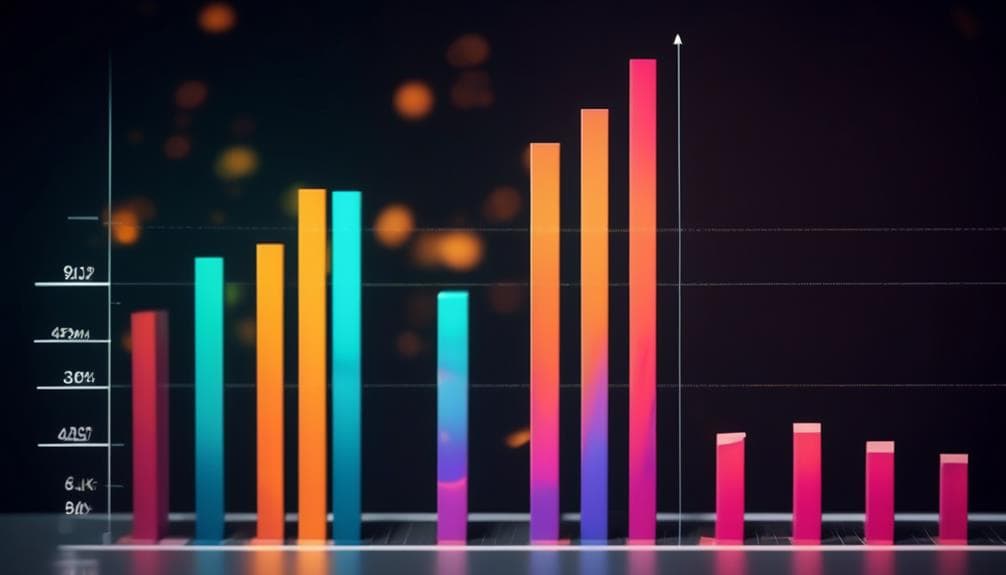Competitive Analysis: Benchmarking Your Social Media Performance
Have you ever wondered how your social media performance stacks up against your competitors?
The realm of competitive analysis in the digital landscape can reveal crucial insights that may significantly impact your social media strategy.
As you embark on this journey of benchmarking, you'll uncover hidden opportunities and gain a deeper understanding of where you stand in the competitive arena.
Understanding the strategies and tactics employed by your rivals could be the key to unlocking your social media success.
Key Takeaways
- Competitive analysis enhances social media strategy by providing insights into competitors' performance.
- Identifying key competitors is crucial for positioning and performance evaluation in the social media landscape.
- Metrics like engagement rates and follower growth serve as benchmarks for comparison and improvement.
- Leveraging insights from competitive analysis drives strategic decision-making and optimization for growth in the digital realm.
Importance of Competitive Analysis

Competitive analysis is a crucial component in optimizing social media performance benchmarking strategies. Understanding your competitors is key to gaining a strategic advantage in the ever-evolving landscape of social media. By conducting a thorough analysis of your competitors' strengths and weaknesses, you can identify opportunities for improvement and innovation within your own social media strategy.
When you delve deep into your competitors' social media activities, you unearth valuable insights that can inform your own content creation, engagement tactics, and overall digital marketing approach. By benchmarking your performance against that of your competitors, you can identify gaps in your strategy and capitalize on areas where you excel. This data-driven approach enables you to stay ahead of the curve and adapt quickly to changes in the competitive landscape.
Identifying Key Competitors
Having understood the significance of analyzing your competition in social media performance benchmarking, now pinpointing your key competitors is essential for gaining a strategic edge in the digital landscape. Identifying key competitors allows you to assess your position in the competitor landscape and enables a more focused performance comparison. By analyzing your competitors' strategies, content, and engagement metrics, you can uncover insights to refine your own social media approach.
| Competitor | Social Media Platform | Follower Count |
|---|---|---|
| Competitor A | 100K | |
| Competitor B | 80K | |
| Competitor C | 120K |
Understanding where your competitors excel can highlight areas for improvement in your social media tactics. Analyzing the performance metrics of key competitors not only provides benchmarks for success but also reveals opportunities for innovation and differentiation. This data-driven approach to competitor analysis sets the stage for strategic decision-making in enhancing your social media presence.
Metrics for Comparison

To effectively compare social media performance, you must focus on specific metrics that provide valuable insights into your competitors' strategies and engagement levels. Two key metrics for comparison are engagement rates and follower growth.
Engagement rates encompass likes, comments, shares, and overall interactions on social media platforms. By analyzing these rates for both your brand and competitors, you can gauge the level of audience involvement and the effectiveness of content strategies.
Follower growth is another crucial metric as it indicates the rate at which an audience is expanding. Monitoring how quickly competitors are gaining followers can offer valuable insights into the appeal of their content and the overall success of their social media campaigns.
Tools for Analysis
Analyzing social media metrics efficiently requires utilizing specialized tools that can provide in-depth insights into engagement rates and follower growth for both your brand and competitors. To enhance your social media analysis capabilities, consider the following tools:
- Sprout Social: This tool offers comprehensive content analysis, helping you understand what resonates with your audience and your competitors.
- Hootsuite: With robust engagement tracking features, Hootsuite allows you to monitor interactions across multiple social media platforms effectively.
- BuzzSumo: Ideal for content analysis, BuzzSumo helps identify top-performing content in your industry, enabling you to optimize your strategy.
- Brandwatch: Utilize this tool for in-depth competitor analysis, tracking their engagement metrics and providing valuable insights for your own campaigns.
- Falcon.io: Falcon.io offers a holistic approach to social media management, combining content analysis and engagement tracking for a complete overview of your performance.
Leveraging Insights for Strategy

As you navigate the realm of social media performance benchmarking, it's crucial to emphasize strategy optimization techniques.
By leveraging insights gained from data-driven decision making, you can fine-tune your approach for maximum impact.
These strategic adjustments based on concrete data points pave the way for enhanced performance and growth in the digital landscape.
Strategy Optimization Techniques
By harnessing valuable insights obtained from data analysis, organizations can strategically optimize their social media performance for enhanced engagement and effectiveness. To excel in this optimization process, consider the following techniques:
- Content Analysis: Evaluate the performance of different types of content to understand what resonates best with your audience.
- Audience Segmentation: Divide your audience into segments based on behavior, preferences, or demographics to tailor content more effectively.
- Competitor Benchmarking: Analyze the social media strategies of your competitors to identify areas for improvement and innovation.
- Ad Performance Monitoring: Track the performance of your paid advertisements to optimize targeting and messaging for better results.
- Influencer Collaboration: Identify and collaborate with influencers whose audience aligns with your target demographic to amplify your reach and engagement.
Data-driven Decision Making
Effective utilization of data insights is paramount for shaping strategic decisions in the realm of social media performance optimization. By leveraging data-driven insights, you can enhance your understanding of audience behavior, content performance, and competitor strategies, enabling you to make informed decisions that drive success. Here is a table illustrating how data can be utilized for performance optimization:
| Data-driven Insights | Impact on Strategy | Expected Outcome |
|---|---|---|
| Audience Engagement | Tailored Content | Increased Interaction |
| Competitor Analysis | Strategic Positioning | Competitive Edge |
| Trend Identification | Timely Content Creation | Higher Relevance |
Monitoring and Adjusting Strategies
Closely monitoring social media performance metrics allows for timely adjustments to enhance overall effectiveness. By evaluating your strategies and tracking performance metrics, you can ensure you're on the right path to achieving your social media goals.
Here are key actions to take in monitoring and adjusting your strategies:
- Real-time Tracking: Utilize tools that offer real-time data to stay updated on how your strategies are performing instantly.
- Competitor Analysis: Regularly compare your performance metrics with those of your competitors to identify areas for improvement.
- Audience Engagement Assessment: Monitor how your audience is engaging with your content to tailor your strategies accordingly.
- ROI Calculation: Continuously calculate the return on investment for your social media efforts to optimize resource allocation.
- A/B Testing: Conduct A/B tests on various elements of your strategies to determine what resonates best with your audience.
Consistent monitoring and adjustment of your social media strategies based on these insights will lead to a more effective and impactful online presence.
Frequently Asked Questions
How Can I Effectively Use Social Media Analytics to Track My Competitors' Performance?
To effectively track your competitors' performance using social media analytics, focus on industry trends and data comparison. Conduct thorough competitor analysis for performance tracking. By staying informed and analyzing data, you can gain valuable insights and make informed decisions for your social media strategy.
What Are Some Common Pitfalls to Avoid When Conducting Competitive Analysis on Social Media?
When conducting competitive analysis on social media, avoid biases by setting clear objectives. Stay focused on relevant metrics and trends rather than personal opinions. Analyze data objectively to uncover insights that drive innovation and growth.
How Can I Identify Emerging Competitors in My Industry Through Social Media Benchmarking?
To identify emerging competitors in your industry through social media benchmarking, focus on identifying trends and analyzing the industry landscape. Look for new players gaining traction, engaging audiences, and shaping conversations to stay ahead.
What Role Does Audience Engagement Play in Determining the Success of a Competitor's Social Media Strategy?
Audience engagement is vital in analyzing competitor success on social media. By evaluating audience interactions and engagement metrics, you can gauge the effectiveness of their content strategy. Understanding how competitors respond can guide your own strategy for improvement.
How Can I Ensure That My Competitive Analysis on Social Media Remains Relevant and Up-To-Date Over Time?
To stay updated and relevant in your competitive analysis on social media, continuously monitor industry trends. Implement tools for data tracking and analysis. Regularly review and adjust your strategies based on the insights gained. Be proactive in adapting to changes for sustained success.
Conclusion
In conclusion, conducting a competitive analysis of your social media performance is essential for gaining insights into your industry landscape. By identifying key competitors, comparing metrics, and leveraging tools for analysis, you can make data-driven decisions to enhance your strategy.
Monitoring and adjusting your approach based on these insights will help you stay ahead in the competitive social media landscape. Keep analyzing, adapting, and optimizing to continuously improve your social media performance.








